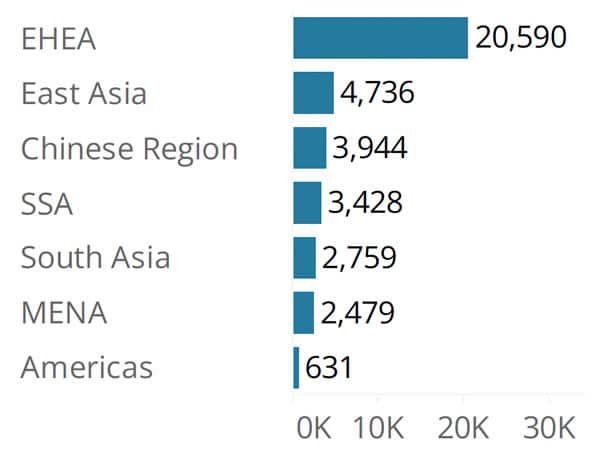Number of English-taught degree programmes rises by 22% from 2021 to 2024
- Between 2021 and 2024, the number of on-campus English-taught programmes rose by 22%
- More ETPs outside of the “Big Four” anglophone destinations creates opportunities for students looking for alternatives to Australia, Canada, the US, or the UK due to policy settings or high visa refusal rates in those countries
A new report from British Council and Studyportals, “Mapping English-taught Programmes Worldwide,” reveals that in 2024, there are 22% more on-campus English-taught bachelor’s and master’s programmes (ETPs) being delivered globally than in 2021. Much of the growth has occurred in alternative (“non-traditional”) destinations.
Data for the report was primarily drawn from Studyportals’ database, which comprises more than 240,000 ETPs worldwide and encompasses over 3,500 higher education institutions.
The number of ETPs has, since 2014, tripled to 40,786 in countries outside of Australia, Canada, the UK, and US (aka the “Big Four” anglophone destinations), with most of these ETPs being offered at the master’s level (63%).

Which alternative destinations offer the most ETPs?
The region commanding the highest share of ETPs outside the Big Four is the European Higher Education Area (50%). Germany, Ireland, and the Netherlands offer the most ETPs in Europe, but the fastest growth in English-taught programmes has occurred in Türkiye, Italy, and Portugal.
After Europe, East Asia offers the second-highest number of ETPs outside of the Big Four (12%.) Studyportals notes an important shift in the distribution of ETPs in Asia:
“It is valuable to highlight that the availability of ETPs in East Asia has far surpassed the supply of the Chinese region, which is a considerable shift from what was seen in the 2021 report. As a result, this puts East Asia in a new perspective as it expands on the internationalisation of programmes, in particular with programmes offered by Malaysian institutions.”
South Africa is another country that offers more ETPs than China.

Market share declines for Big Four
As ETPs increase in alternative destinations, the market share of ETPs claimed by the Big Four has dropped from 82% in 2021 to 78% in 2024. While this is a notable drop, the Big Four do still offer the vast majority of ETPs.
Why ETP growth in non-traditional destinations is increasingly important
The implications of more ETPs being delivered in alternative destinations are quite significant. Edwin van Rest, co-founder and CEO of Studyportals, said:
"The surge in English-taught programmes outside traditional anglophone destinations marks a significant shift in global education. As universities across the globe rapidly adopt English as a medium of instruction this means more symmetrical talent flows as traditional student origin countries also become more compelling study destinations. This expansion provides students with more competitive and affordable opportunities, while also intensifying the competition for established institutions, particularly in light of stricter entry requirements and visa uncertainties.”
Alternative destinations are poised to win still greater market share of students seeking English-taught programmes given policy developments in Australia, Canada, and the UK that are making it more difficult for many students to obtain visas to study in those countries.
Studyportals elaborates:
“The expansion of on-campus English-taught programmes outside the traditional anglophone destinations has profound implications for global student mobility. This trend means that prospective students now have access to a broader array of academic programmes in a wider range of countries than ever before.”
Popular fields of study
The highest rate of growth for ETPs (from 2019 to 2024) is accounted for by Computer Science & IT (+63%) – a broad field that includes Artificial Intelligence, Machine Learning, Software Engineering, and Data Analytics – as well as Natural Sciences & Mathematics and Agriculture & Forestry (both +62%). Notable increases also characterise Environmental Studies & Earth Sciences (+58%), Humanities (+58%), Medicine & Health (+57%), Engineering & Technology (+54%), and Education & Training (+50%).
ETPs by country
The following table from the report details the number of ETPs in various destination countries.

For additional background, please see:
















